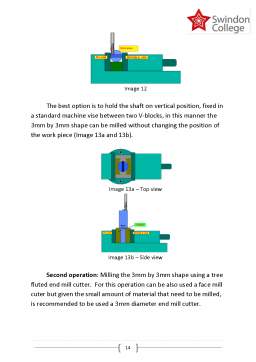Cuprins
- Contents
- Summary: 3
- Introduction: 3
- Processes, data requirements and machine tools 3
- Manufacturing process 8
- Turning process 9
- Horizontal milling process 12
- Grinding process 15
- Conclusion 16
- Refferences: 16
Extras din referat
Summary:
Conventional machining processes such as turning, milling, drilling, abrasive cutting, and grinding are used to generate complex shapes by removing material in the form of tiny chips.
Turning utilizes a single point cutting tool that is steadily feed against a rotating work piece in order to generate cylindrical surfaces. In a milling process, the cutting tool which often has multiple cutting edges rotates around its axis while a feed motion is introduced in the work. Grinding is a material removal and surface generation process used to shape and finish components made of metals and other materials. An abrasive product, usually a rotating wheel brought into controlled contact with a work surface.
Introduction:
The purpose of this assignment is to explain how conventional machine tools are used to produce a shaft according to the engineering drawings, and to describe the basic functional principles of machine tools. The second part of the assignment explains in brief the manufacturing process of the shaft component and gives alternative methods of work holding techniques.
Processes, data requirements and machine tools
According to the engineering drawing (appendix 1) the company XYZ ltd must produce a shaft. Before the mass production of the shaft the production department has to establish the process, time of production of each operation, the data requirements (tolerances, surface finish) and the machine tools needed to produce the component to the required quality standards.
According to the engineering drawing the data requirement to produce the shaft are incomplete. The drawing shows only the final dimensions of the shaft. The dimensional tolerances, the surface finish and the type of material needed are missing. For that reason the tolerances has been defined to be -0.25/0 mm, the surface finish has to be a smooth finish, and the material used to produce the shaft is steel-low carbon.
The appropriate conventional machines tools required to produce the shaft are: lathe, horizontal milling machine, surface grinding and cylindrical grinding machine. The lathe (Image 1) is a machine tool which turns cylindrical material, touches a cutting tool to the work piece and cuts the material (Image 1a). Turning is the removal of metal from the outer diameter of a rotating cylindrical work piece. Turning is used to reduce the diameter of the work piece, usually to a specified dimension, and to produce a smooth finish on the metal.
Image 1a
https://www.nmri.go.jp/eng/khirata/metalwork/lathe/intro/factors_e.jpg
The operations that can be performed on a late are: turning, facing, boring, drilling, threading and knurling. Each operation requires specific cutting tools, such as: single point left hand or right hand cutting tool, threading tool, finishing tool, profile tool, parting tool, etc. (Image 2) The surface finish depends upon the material used, feeding speed, the type of cutting tools and the cutting fluid used during the operations.
Preview document
Conținut arhivă zip
- Understanding the Use Of Conventional Machines.docx
















